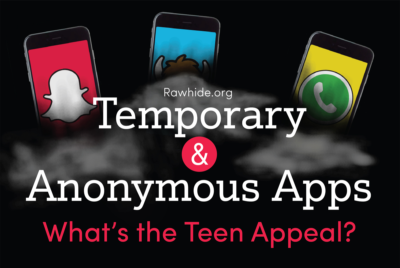
Self-destructing or anonymous messaging apps, much like one would see in a spy movie, are the latest digital trend for teens. These temporary or anonymous apps allow teens to send messages, images, videos, and other digital content anonymously. Content may self-destruct or vanish after a set time as well. Teens find a sense of security in the anonymity and temporary nature of these apps. However, these features may encourage teens to act uncharacteristically and send questionable or harassing content users wouldn’t normally send.
Realistically, shared content may not disappear or remain anonymous. Cyber predators use temporary or anonymous apps to create a sense of security to gain personal or revealing content from teens. The temporary and anonymous nature of these apps makes tracing questionable interactions difficult because content “disappears.” Many teens use at least one temporary or anonymous app, and parents can take action to prevent their teen from encountering the dangers that lurk in these apps.
Temporary and Anonymous Apps: What’s the Teen Appeal?
Teens turn to anonymous or temporary messaging apps to assert their independence and escape from popular social media their parents might be on such as Facebook or Twitter. But with independence comes various issues, threats, and dangers. Anonymous or temporary messaging apps allow teens to post content anonymously or share content that is supposed to disappear after a selected amount of time. But content doesn’t always disappear. Screenshots of embarrassing or revealing content might be taken and shared to humiliate the sender. Sexting, cyberbullying, and talking to strangers are also likely, opening the door for cyber predators to lull teens into trusting relationships to gain personal or revealing information. While temporary or anonymous apps give teens a chance to assert their independence, they also expose teens to new dangers they may not be prepared for.
Definition of Temporary or Anonymous Apps
Temporary apps allow teens to send messages and images that self-destruct or vanish after a set time.
Anonymous apps allow teens to send content anonymously. Users of anonymous apps can hide their location or information about themselves so others can’t tell who content is coming from.
Temporary and anonymous apps gained popularity for teens wanting to assert their independence and get away from sites their parents use such as Facebook and Twitter.
Teens Cover their Digital Footprint
Teens may use temporary or anonymous apps to manage their digital footprint. The sense of security surrounding temporary and anonymous apps can entice teens to send questionable content and communicate in ways they wouldn’t normally. This may include cyberbullying because they feel it’s easier to do or sexting because messages “disappear.”
“Though most teens are only sharing day-to-day moments with an already tight social group, there can be unintended consequences when teens think temporary messages really disappear forever or when they make mean comments under cover of anonymous apps.”- Christine Elgersma, Senior Editor at Common Sense Media
Top 9 Temporary or Anonymous Apps
Nine temporary or anonymous apps have gained substantial popularity amongst teens. The anonymity, disappearing nature, and easy-to-learn platforms are attractive to teens. While there are more than nine temporary or anonymous apps in existence, Snapchat, Kik, Whisper, Yik Yak, Omegle, WhatsApp, Ask.fm, Burn Note, and Line remain the most popular.
Snapchat
- What is Snapchat?–Snapchat is a disappearing, temporary messaging app that allows users to send text, photos, and videos to anyone on their friend list. The sender determines how long the receiver can view the image and the image “destructs” after the allotted time.
- Stats- 41% of United States teens use Snapchat multiple times a day. Click to Tweet!
- The Appeal- Snapchat is the fastest growing and number one most used app for teens.
- 35% of teens use Snapchat solely because their content disappears Click to Tweet!
- 10% of teens took a screenshot of a Snapchat and shared it to embarrass the sender
Kik
- What is Kik? – Kik lets users send texts, pictures, videos, and offers other mini-apps. Those allow users to do anything from exchange virtual greeting cards to chat with strangers. Users don’t have to reveal identity.
- Stats – 64.8 million teens use Kik and 40% of American teens use the app.
- The Appeal – Kik is easy to use for teens and has a minimum age of 13 but has no verification method. Kik doesn’t require a phone number and teens can send unlimited messages. Group messaging and in-app web surfing are also features.
Whisper
- What is Whisper? – Whisper is a social “confessional” app that allows users to post whatever and remain anonymous.
- Stats – Whisper restricts users to only 17 years old or older, but this is not enforced. An estimated 800,000 users under 18 use Whisper.
- The Appeal – Teens use Whisper to share deep secrets or opinions about social topics or people without any repercussion.
Yik Yak
- What is Yik Yak? – Yik Yak allows users to post text-only messages anonymously that can be viewed by 500 users closest to the poster. Yik Yak uses GPS tracking.
- Stats – Yik Yak has 1.8 million monthly active users and is most popular around college campus areas
- The Appeal – Teens can make incendiary comments they wouldn’t normally make if people knew they were saying it, making cyberbullying and harassment easier. Yik Yak also recently added a chat feature.
Omegle
- What is Omegle? – Omegle is an anonymous chat app where users discuss whatever they’d like. Omegle’s content often contains lewd language, sexual content, and drugs, alcohol, and violence.
- Stats – 40% of Omegle users are between ages 15-18.
- The Appeal – Users can anonymously discuss anything they’d like. The conversations often turn lewd, vulgar, and dangerous, incorporating drugs, alcohol, and violence.
- What is WhatsApp? – WhatsApp is a mobile messenger that allows teens to communicate with all contacts on their device. WhatsApp allows users to send unlimited images, video, and text as well as group chats.
- Stats – 25% of teens with a mobile device use WhatsApp.
- The Appeal – WhatsApp offers teens a messaging platform to escape from parents and grandparents without using their phone plan. WhatsApp does not filter adult content, potentially exposing teens to risky content.
Ask.fm
- What is Ask.fm? –fm is a social site that lets teens ask questions and answer questions others post. Questions are often asked anonymously.
- Stats – 28 million registered users under age 18 use Ask.fm.
- The Appeal – Teens are attracted to the anonymous questions. While the questions prompt healthy discussions, sexual content is also posted.
Burn Note
- What is Burn Note? – Burn Note is a temporary messaging app that erases messages after a set time frame. Burn Note is text only.
- Stats – Over 10,000 users have installed this app.
- The Appeal – Burn Note has a unique display system that reveals only one word at a time, making the messaging more secretive. The message “burns” after reading.
Line
- What is Line? – Line is a multifaceted text, video, and voice-messaging app that also features social media elements such as games and group chat.
- Stats – Line has 218 million monthly active users worldwide.
- The Appeal – Line is an all-in-one social media featuring emoticons, stickers, free texting, and video calls. Line also has a “hidden chat” where users may choose how long they’d like their message to last before it vanishes.
Ripped from the Headlines
Yik Yak has caused serious disruptions for many schools. Threats of shootings, bombings, or other violent events directed at schools across the country have been made over Yik Yak. Schools have also encountered students making racist threats and sexually aggressive comments that create a hostile environment for other students.
Yik Yak isn’t the only anonymous app that’s created headlines.
- Kik was recently linked to the murder of a 13 year old girl
- 9 Teen suicides in 12 months were linked to anonymous harassment endured on Ask.fm
- A Florida teen recently took her own life due to bullying occurring via Snapchat
Parents Left in the Dark
Many parents aren’t aware of temporary and anonymous apps, despite the emerging press coverage and dangers associated.
- 72% of parents are concerned about their child’s online activity
- 70% of teens hide their online behavior from their parents
- 25% of teens say their parents know little or nothing about their online behavior
The fact that parents are under-informed about temporary and anonymous apps, gives teens another way to cloak their online behavior.
The Hidden Dangers
Anonymous apps may provide a false sense of security. Studies show that even anonymity does not protect teens from cyberbullying, stalking, or other threats.
Cyberbullying – Anonymity can encourage cruel behavior from teens without fear of repercussions. Ask.fm has been associated with 9 teen suicides due to users consistently harassing others.
Cyberstalking – Anonymous chat allows predators to create fake accounts allowing them to find teens easier. Predators can then lull teens into a sense of security. Once trust is established, cyber stalkers and cyber predators may gain access to the different social channels a teen uses and collect sensitive and personal information.
Sexting – The anonymity behind anonymous apps may encourage teens to pursue riskier relationships and engage in riskier actions such as sexting.
Lost Evidence – Temporary apps have disappearing messages that eliminate evidence of any negative content that was shared between people. This can make it difficult to prove inappropriate messages were sent.
GPS Reveals Location – Some anonymous apps are location based and make looking up locations of teens easy for predators.
Bots – Bots may disguise themselves through suggestive, personalized messages that trick users into viewing adult content. Bots may cause computer viruses.
Exposure to Adult Content – Some anonymous apps don’t require age verification. This may result in minors being exposed to pornographic content.
Hyper-local Anxiety – Aggression and bullying threats can now come within a close proximity, causing anxiety that a threat might be close.
Anonymity Not Guaranteed – While anonymous and temporary apps might make users think the content is temporary or disappears, users can still screenshot pictures or texts. Taking screenshots before an image disappears is common on Snapchat.
- 52% of teen Snapchat users have had others screenshot their content
- 47% of Snapchat users take screenshots of other people’s content
What Can Parents Do?
While teens prefer hiding their online behaviors from their parents, parents influence teen online behavior.
If you’re worried about your teen’s online behavior, consider taking the following actions to protect your teen from trouble.
- Establish boundaries – Remind teens not to communicate with strangers, reveal personal information, bully, or share inappropriate information.
- Expose teens to real-world dangers – Show teens examples of extreme, unsafe online behaviors. Show them what they post can potentially harm themselves or others.
- Discuss privacy settings – Check teen’s privacy settings. Make sure they understand how to navigate privacy settings and block people.
- Stay current – Monitor and educate yourself about the apps your child is using. An internet search about “teens new favorite apps” can help reveal the newest digital trends.
- Explain the true impact of your teen’s actions – Inform teens that other users may screenshot anonymous posts. Embarrassing or questionable posts may come back later.
- Hide phone numbers on public profiles – Don’t let teens disclose phone numbers on social media. Revealing numbers can make it easier for cyber predators to find more information on your teen.
- Check age restrictions – Inspect apps on your teen’s device to make sure they haven’t joined an app they’re not old enough for.
- Disable location sharing – Turn off location tracking features to prevent predators from locating where your teen is.
- Software Filters – Use programs to monitor social media, block chats, and mask profanity.
While anonymous apps provide teens a fun way to explore social media sites other than Facebook or Twitter, they also present dangers. Talking to your teen about the dangers and taking action can help your teen stay safe online and prevent any actions that might be harm them or others.










